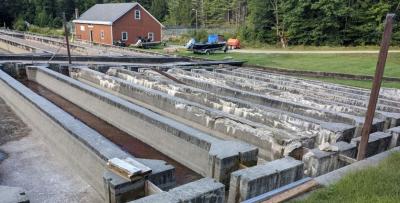NH Fish Hatchery Modernization Project
Improving New Hampshire's Trout and Salmon Hatcheries

New Hampshire Hatcheries produce over a million fish each year for stocking lakes, ponds, and rivers for anglers to enjoy. The facilities are outdated and in desperate need of repair and upgrades, to make them more cost-effective, environmentally friendly, and energy efficient. Some of the issues to address are outdated electrical systems, broken equipment, rotting wood, asbestos, failing concrete, and wastewater treatment.
NHFG received funding through the American Rescue Plan Act (ARPA) to improve water quality and operational efficiency by modernizing and improving these facilities. The project is slated for completion by the end of 2026.
Background
New Hampshire’s nickname is the Granite State. Although beautiful, granite has no calcium, an important mineral that impacts stream productivity. Calcium promotes/supports good water quality and is important for the growth of fish and the smaller fish and bugs they eat. Overall granitic soils are low in essential nutrients, negatively impacting growth. This translates into waters with relatively poor capacity for growing bugs (bottom of the food chain) and smaller fish. The use of cultured fish in New Hampshire helps to alleviate the pressure on wild trout species and maintain desired angler satisfaction rates.
Species that ranked among the top five preferred by anglers include rainbow trout, stocked brook trout, and brown trout. The use of cultured trout and salmon is therefore essential to meet these preferences, as well as the desire for improved growth/size of trout fisheries in New Hampshire. To do this currently involves the operation of six hatcheries with an overall budget of about $4 million annually. An estimated 228,000 anglers fished 4.4 million days in the state in 2011, according to a national study by the U.S. Fish & Wildlife Service (https://www.census.gov/content/dam/Census/library/publications/2014/demo/fhw11-nat.pdf) with a total expenditure by anglers of $209,000,000.
A recent reassessment has caused Fish and Game to change where it stocks fish, to ensure the fish have a better chance of survival and to reduce stocking in many areas of the state that have a wild trout population or poor habitat for trout survival. We have also taken into consideration New Hampshire’s fairly dense resident population in the south and a heavy influx of angling tourism.
Facilities
In an effort to determine the status of our hatchery infrastructure and production capacity for planning these modernization efforts, HDR Engineering was hired through a competitive bid process to conduct an assessment of each hatchery.



